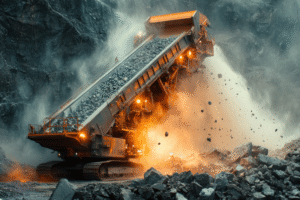Cleanaway Waste Management (ASX:CWY): Is its $5.9bn price right or a load of rubbish?
![]() Nick Sundich, May 15, 2025
Nick Sundich, May 15, 2025
This week’s Australian stock of the week is Cleanaway Waste Management (ASX:CWY). Capitalised at $6bn, it is Australia’s biggest waste management company and the only one that is listed, since Bingo was bought by Macquarie.
Cleanaway has big ambitions for the future, wanting to play a role in recycling. And not just the ‘stick paper and plastic bottles into a dedicated recycling bin’.
Introduction to Cleanaway Waste Management
Cleanaway’s origins trace back to being the waste management division of Brambles (ASX:BXB) in 1979. Brambles sold it out in 2005 to Transpacific Industries and the company was listed on the ASX in that same year. The first decade or so was difficult, cycling through four CEOS in 3 years at one stage and bearing $2.1bn in debt.
Things took a turn for the better during the tenure of Vik Bansal as CEO. His tenure lasted nearly 6 years between 2015 and 2021 during which the company went from $1bn to $5bn in its market capitalisation. Bansal departed at the start of 2021 in controversial circumstances that we’d rather not go into here and was replaced by Mark Schubert, a former executive of Origin Energy.
Today, the business has contracts with 130 local councils and 150,000 business customers, running 5000 trucks on the road. Since mid-2022, the business has largely flatlined, at least as far as its share price is concerned. Why? We’ll get to that shortly.
Big ambitions for the future
But it is not just a bin collection company. It also recovers construction materials, is a part of the container deposit scheme in NSW and will be part of Victoria’s from November. Specifically, it will be responsible for collecting containers from vending machines in roughly a third of the state.
Cleanaway also wants do help minimise ‘red bin waste’ going to landfill. So it has been on a major buying spree in recent years. In late 2021, it forked out $501m to buy two rubbish dumps and five waste transfer stations in Sydney from Suez. This was a compromise from buying the entire Suez Australian business from its head office in Paris – a plan that was foiled after it merged with fellow conglomerate Veolia.
In August 2022, it bought Western Sydney group GRL for $169m. This is a company that processes about 20% of red bin mixed waste annually, composting in open air. Cleanaway plans on transitioning it to an indoor facility within the next few years and so it raised $400m at the time it bought it. It has exclusive rights to send waste to the GRL facility and will benefit from NSW government regulations that will result in all households having a dedicated bin for food waste by 2030.
And finally, it is working on two waste-to-energy plants in Victoria and Queensland. The plan is to have these up and running by 2027, but it could cost up to $2bn.
Revenue will be mostly from gate fees paid by those transporting rubbish while another 10-15% of forecast revenue will come from the sale of electricity to outside customers. Cleanaway’s site in Victoria (at Wollert) is near large industrial companies that could use it.
Cleanaway’s recent results
Cleanaway’s recent results have been a mixed bag, in our view. Let’s start with FY23. Although its revenues increased 18% to $3.6bn, its operating profit fell from $169.3m to $129.4m (a 25% drop) and its statutory NPAT declined from $80.6m to $23.5m (a 71% fall). This was due to amortisation and higher net finance costs (81% higher than the year before).
Nonetheless, Cleanaway’s EBIT increased $257.1m to $302.2m (up 18%) and the company set a target of $450m in FY26. This would represent a margin of 11.2% compared to 8.4% then.
Looking to FY24, the company’s net revenue increased 8% to $3.2bn, its EBIt by 19% to $359.2m and its profit by 15% to $170.6m. Its ROIC was 5.5%, up 60 basis points on FY23, and it paid a dividend of 5c per share (equating to a payout ratio of 63.9%). CWY reiterated its ‘$450m EBIT by FY26’ goal and guided to $395-425m for FY25. Speaking of meeting targets, the company confirmed it was on track to meet its emission reduction targets noting its emissions were down 6% overall and methane was down 7.8%.
In 1H25, it again reiterated its full-year goal and stated it was on track. Its revenue grew 7.7%, its EBIT by 18.9% and the company’s underlying profit was actually higher than its statutory profit, it came in at $170.6m which was 14.8% ahead of 1H24.
Only a month later, CWY announced it was buying Contract Resources, a company that provides catalyst handling, decontamination, chemical cleaning and related services. The deal was priced at just 5.9x EV/EBITDA for FY25 (inclusive of synergies). But this did mean an enterprise value of $377m. It is subject to ACCC approval – a decision should happen by the end of this year.
CWY boasted this could help it get exposure of the Dismantlement, Removal, and Restoration (DR&R) market as oil use winds down. It is estimated that there are $43bn worth of opportunities over the next 5 decades.
Why we wouldn’t buy it now
This all sounds great, doesn’t it? And analysts agree with a $3.05 per share target price, up 11% from the current price. They call for $3.95bn revenue and $795.9m EBITDA in FY25 (up from $3.76bn and $728.7m respectively), followed by $4.2bn revenue and $886.4m EBITDA in FY26 and then $4.6bn revenue and $974.7m EBITDA in FY27. Analysts expect some growth will be derived from the company’s acquisitions.
But, just as is the case with Qantas’ fleet renewal, these big ambitions will have to be paid for somehow. Yes, the costs are nowhere near as big as Qantas’ fleet renewal, but we anticipate hefty shareholder dilution.
Another problem this company has been facing of late is labour shortages. Yes, we know this is a problem at all companies. But at Cleanaway, it was so bad that corporate management had to get behind the wheel. This issue was a drag on its profit.
Whether through debt or equity, the company will need finance to follow through with its ambitions without entering into negative cash flow territory. So, even though the business is in an enviable market position, has a good opportunity ahead of it as well as a potential ESG angle (albeit down the track rather than right at the moment), plus its high multiple of nearly 30x P/E and 1.8x PEG, we would pass it on at this point in time.
What are the Best stocks to invest in right now?
Check our buy/sell stock tips
Blog Categories
Get Our Top 5 ASX Stocks for FY26
Recent Posts
Larvotto Resources is fully funded for its $694M Hillgrove Project
18% Jump for Larvotto Resources as Hillgrove Construction Moves Ahead, Backed by $175M in New Funding Larvotto Resources (ASX: LRV)…
Archer Materials Cracks Quantum Readout Challenge as Stock Surges 12%
Archer Materials Just Solved One of Quantum Computing’s Hardest Problems Archer Materials (ASX: AXE) jumped 12% today after unveiling two…
NVIDIA’s Blackwell Chips Ignite Record Demand in Q3
NVIDIA’s Blackwell Surge Tech investors and growth-focused funds will be breathing a sigh of relief after NVIDIA (NASDAQ: NVDA) delivered…



